
To read Bahasa Indonesia version of this article click here
Key Points
- Major Indonesian feedlot operator closes its business permanently
- Falling Indian beef prices in Indonesia providing increased competition to fresh beef.
- African Swine Fever spread confirmed in Vietnam and Cambodia.
- Northern Territory wet season fails.
Indonesia : Slaughter Steers AUD $3.78/kg live weight (Rp10,050 = A$1)
Prices remain weak as feedlots are still full of excessively fat, longfed cattle which continue to hold slaughter prices down. The indicator price has dipped slightly once again to Rp38,000 per kg live weight for slaughter ox. With Ramadan commencing on 5 May, this should ensure that prices don’t fall any further and should probably firm once again towards the end of this festival month.
Feedlots have not been able to empty out since October 2018 despite most subsequent months importing close to 40,000 head. March is the exception with a little over 55,000 as importers took advantage of the very cheap prices available for large numbers of drought-stressed feeders from northern Australian producers. This spike in numbers makes sense, as these animals will be exiting the feedlots in July after the Ramadan/Lebaran festival demand peak has cleaned out the backlog once again. Total imports for April appear to be in the 40,000 range once again so back to sensible numbers to meet the expected modest future fresh beef demand.
The competition from Indian beef appears to be ramping up as larger quantities are being offered at lower retail prices, down from Rp100,000 in the early days of supply to Rp80,000 and now Rp70-75,000/kg boneless buffalo beef. As China has gradually closed the door on illegal imports of Indian beef, large volumes have been diverted to other markets at discounted prices with Indonesian consumers appearing to be a beneficiary of this cheaper, redirected product.
The distressed state of the Indonesian feedlot industry was highlighted during April by the closure of one of the country’s largest importer/lotfeeders based in West Java. This company had two large feedlots capable of a total capacity of around 40,000 head and had been a successful operator for decades. They have already sold one location and are running down the remaining cattle in the second before permanently closing the gate there too. The entire industry is under extreme pressure as a result of a wide range of factors from Indian beef to government policies and commercial errors like importing 81,000 head last October which has effectively crushed the market from January until the present day.
The general failure of the Northern Territory wet season is complete, as it is now too late for the monsoon to return so the next rain can be expected in late October/November at the earliest. This has forced the bulk of the feeder cattle to be sold off early and at low rates allowing mid-April CIF Jakarta prices to edge down further to as low as USD$2.55. This delivered price has already increased with the end of April Darwin feeder prices rising to around AUD$2.90 which will translate to a CIF of closer to USD$2.75. Those close to the northern Australian market suggest that a limited number of feeders will still be available through May and June but will become extremely difficult to source and much more expensive from July onwards.
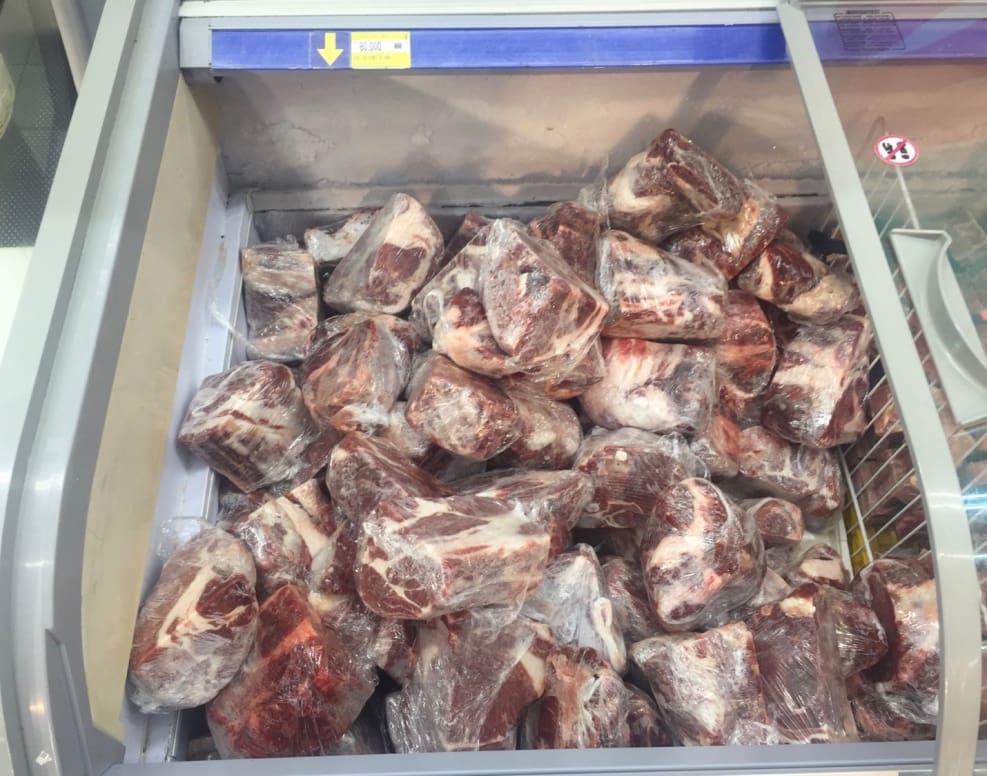
Photo : Hypermart Bengkulu in West Sumatera with frozen boneless Indian Buffalo @ Rp80,000 per kg or AUD$8 per kg.
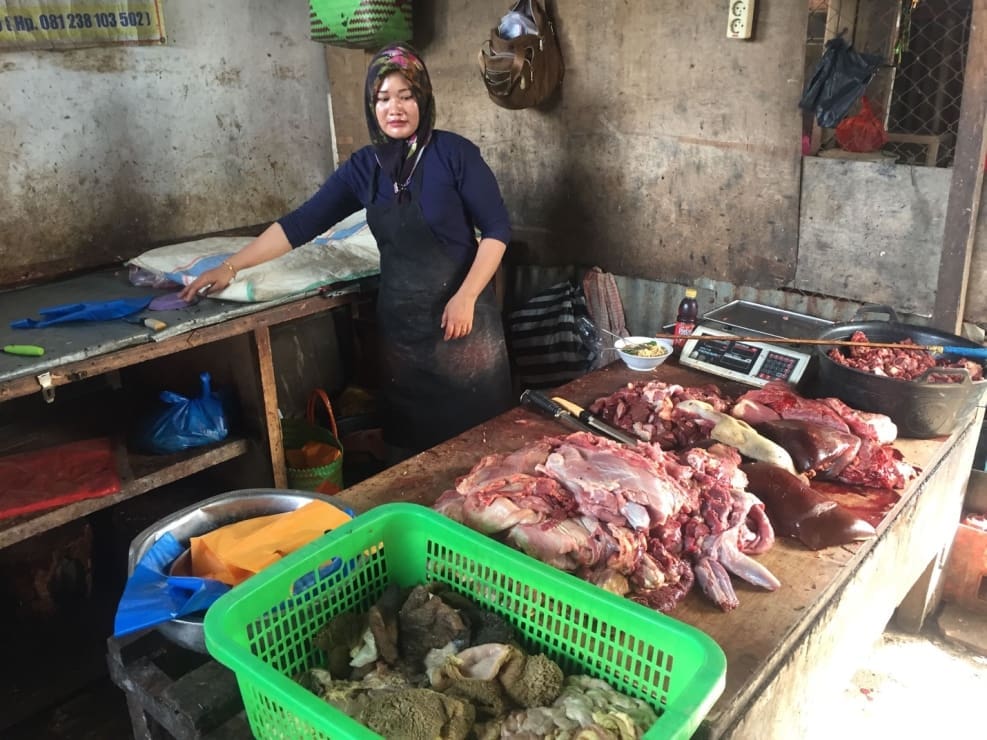
Photo : There are only two beef stalls at the largest wet market in Labuan Bajo, East Flores and this is the best one. The beef and offal is from local Bali cattle with the price of knuckle at Rp110,000 per kg or AUD$11.00.
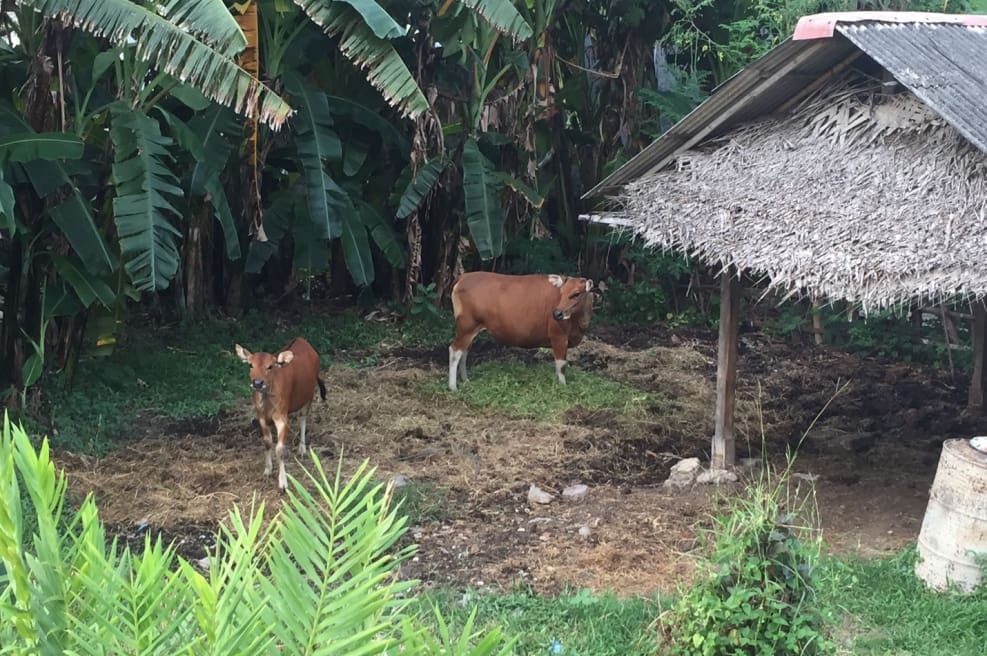
These beautiful Bali cattle are in a backyard about 200m from my house in central Seminyak, Bali. Keeping Bali cattle is more of a Balinese passion than a beef industry
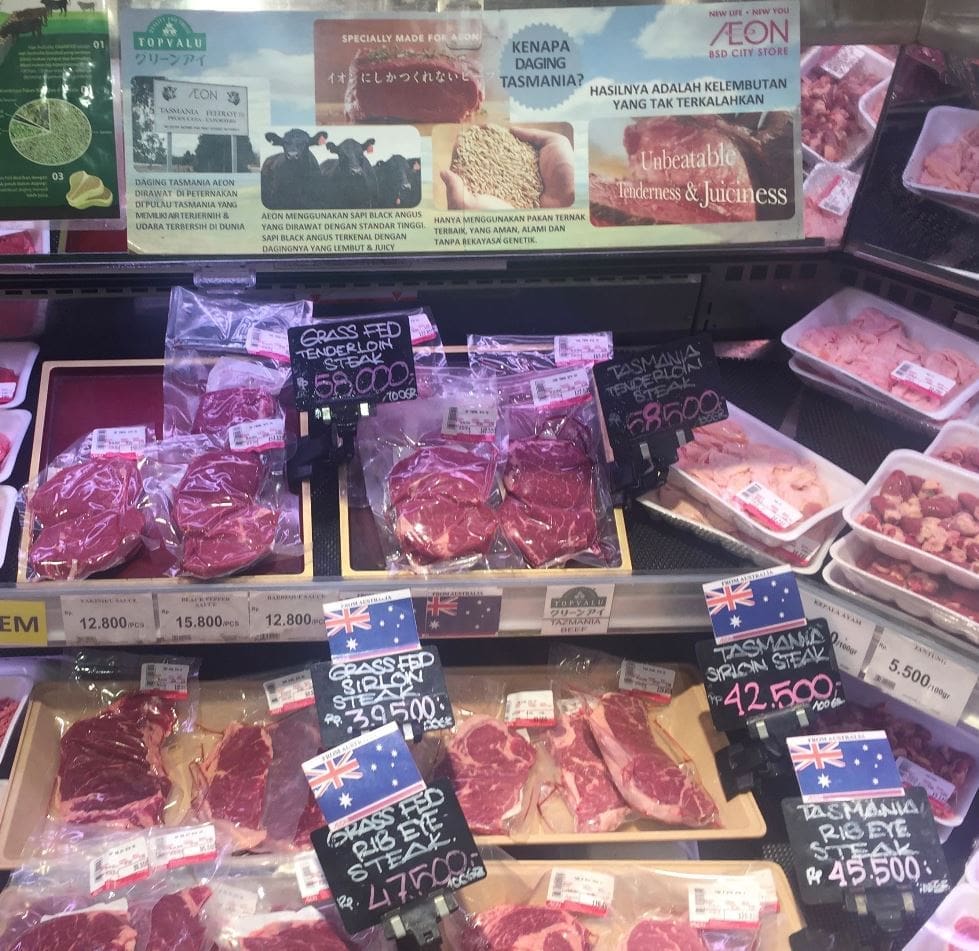
Aeon Mall supermarket in BSD, Jakarta. Just divide the prices by 10,000 to get the approximate A$ rate so Rp42,500 = AUD$42.50. This supermarket chain has strong links with suppliers in Tasmania.
Vietnam: Slaughter Steers AUD $4.42 / kg (VND16,500 to $1AUD)
Prices for all classes of stock are unchanged from last month with the indicator rate for slaughter ox remaining at Dong 73,000 per kg live weight.
Import numbers into Vietnam continue their steady climb with almost 50,000 head imported this calendar year to the end of March. While this is an encouraging start we are still well below the performance of the trade in 2015 when 85,000 were imported for the equivalent period and the annual total was 360,000. The national feedlot capacity of about 100,000 head is currently about 50% full.
The important news for this month was the announcement that African Swine Fever (ASF) has been confirmed in Vietnam and neighbouring Cambodia. With a very large proportion of mainland S. E. Asian families having pigs in the back yard for waste disposal and personal consumption, the likelihood of rapid spread is extremely high. The impact on the region’s pork industry will be enormous with control measures extremely difficult to enforce given the very porous borders of the Greater Mekong region where smuggling is a way of life. A new FAO blockchain technology has been deployed in the Mekong Delta region in an effort to improve the communications between authorities and farmers to better manage livestock management and emergency epidemic measures.
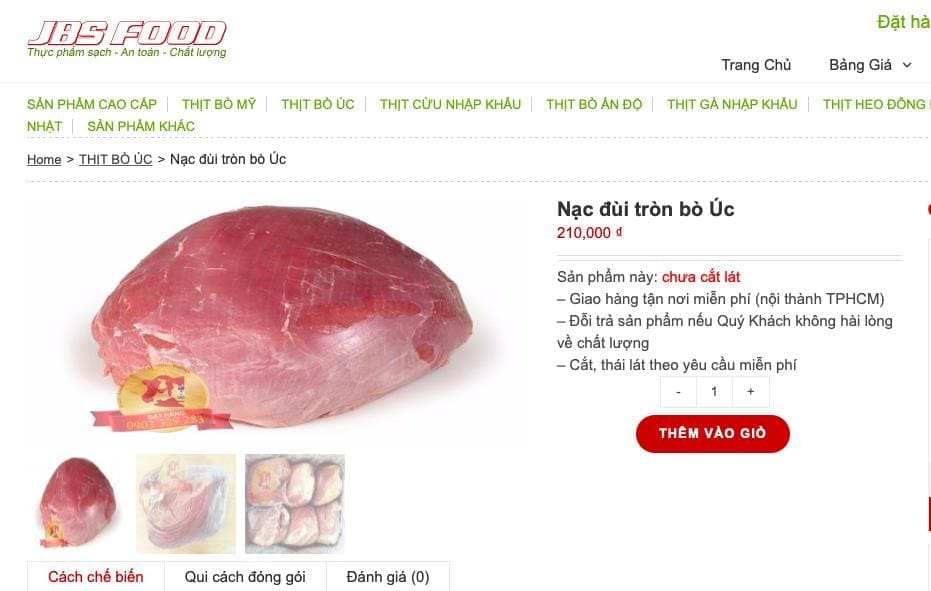
Photo from the internet site of JBS Foods in Vietnam.
China : Slaughter Cattle AUD $5.45 / kg (RMB 4.77 = AUD$)
There has been a very slight decrease in the slaughter ox indicator rate in Shanghai to bring both report prices into line at RMB26 per kg live weight. Retail beef and chicken prices have not changed significantly since the beginning of the ASF outbreak although this situation is predicted to change in the second half of 2019 when the full impact of the national pig herd reduction hits the market. Despite the government’s bold steps to control and eradicate the disease and its facilitation of large volumes of imported pork, the crash in domestic production will still result in a gross destabilisation in the pork market later this year. With no vaccine and a virus that can last for many months in the environment, the risk of reinfection is significant and the recommended period before restocking long. All Chinese farmers operate on state owned land so when they approach the banks for finance their only asset is the stock which they wish to purchase and which are subject to potential reinfection and mandatory slaughter. As a result, many farmers are likely to leave the industry for other less risky sectors or at the very least wait until the situation has stabilised.
Philippines : Slaughter Cattle AUD $4.67 / kg (Peso 36.8 to AUD$1)
Prices for slaughter ox remain the same this month with the strengthening Peso responsible for the slight rise in the AUD price above. The Christian tradition of Lent is a period of reflection and a time for fasting and reduced festivities. The dates of observance during 2019 were between 6th of March until the 18th of April so beef consumption would have been reduced during this period. Despite this the prices for beef and chicken remained quite stable throughout April.
Although the Philippines is separated from China and South East Asia by the sea, smuggling of products from the mainland to the Philippines has long been a popular and profitable pastime. Pigs and pig products are amongst the items traditionally smuggled so the probability of ASF infection being transmitted to the Philippines is very high. If this occurs then the demand and price of beef could move even higher.
Thailand : Slaughter Steers AUD $3.98 / kg (Baht 22.6 to $1AUD)
This month saw a very large drop in slaughter cattle prices from around 98 to 90 Baht. The cause is a serious crackdown by the Chinese authorities on the smuggling of live cattle from northern Thailand into China via Myanmar on the Mekong river. These cattle are officially and legally exported from the port city of Chiang Saen in Thailand, on Laotian river boats, to river ports in northern Myanmar. Once unloaded in Myanmar, the cattle (and buffalo) are smuggled across the river into south west China where they are trucked to the regional cities of Xishuangbanna and Kunming for slaughter. This has been a huge trade in recent years but has declined as the Chinese authorities have gradually reduced the level of the global grey trade. In December 2018 I sailed down the Mekong from S W China to Chiang Saen. During that trip we passed only 5 boats so the daily traffic might be about 100 head per day, well down from the boom time estimates of 600 per day.
I am advised that a significant part of this cross-border grey trade has now been relocated to the northern border crossing of Boten in Laos. This is the location where the new belt and road Chinese railway crosses into Laos on its way to Vientiane.
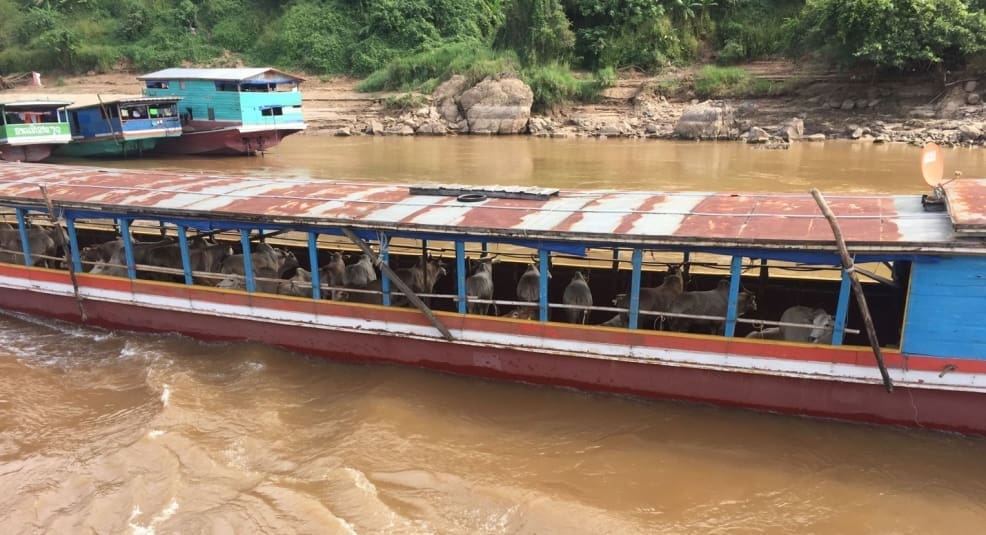
Photo December 2018 : slaughter cattle being legally exported via the Mekong from northern Thailand to northern Myanmar. During my recent boat trip down the river from China to Thailand we passed 5 boats carrying cattle and buffalo upstream to Myanmar. These boats were not fully loaded with plenty of spare space for more stock.
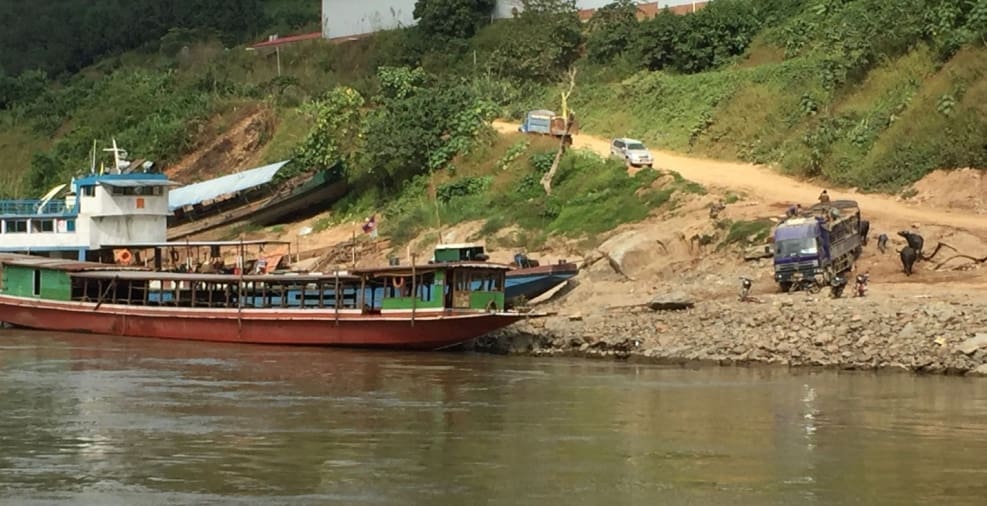
Photo December 2018 : This boat is discharging its buffalo onto a truck on the Myanmar (south west) side of the river. From here it is only a few hundred metres across the river into the south west Chinese province of Yunnan.
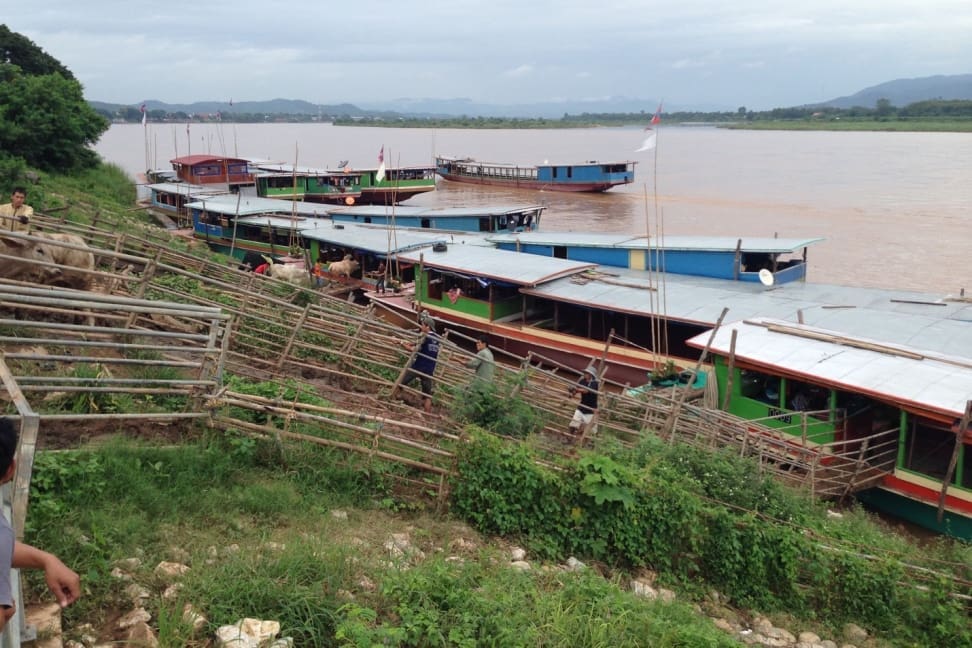
when I visited Chiang Saen in July 2014 the river trade to China was booming with an estimated 5-600 head per day departing up-river for Myanmar and China.
Singapore : almost as expensive as Rome.
Singapore is one of my favourite cities except when it comes to the cost of luxury items, including beef. And you only get about 96 Singapore cents for $1AUD.
Fair Price Supermarket in Scotts Road:
- Lean beef mince S$38 per kg
- Grass fed ribeye S$64 per kg
- Knuckle S$35 per kg
- Stir fry S$40 per kg
Cold Storage Supermarket in Paragon centre, Orchard Road:
- Organic Sirloin S$49.90 per kg
- Stewing beef $29.90 per kg
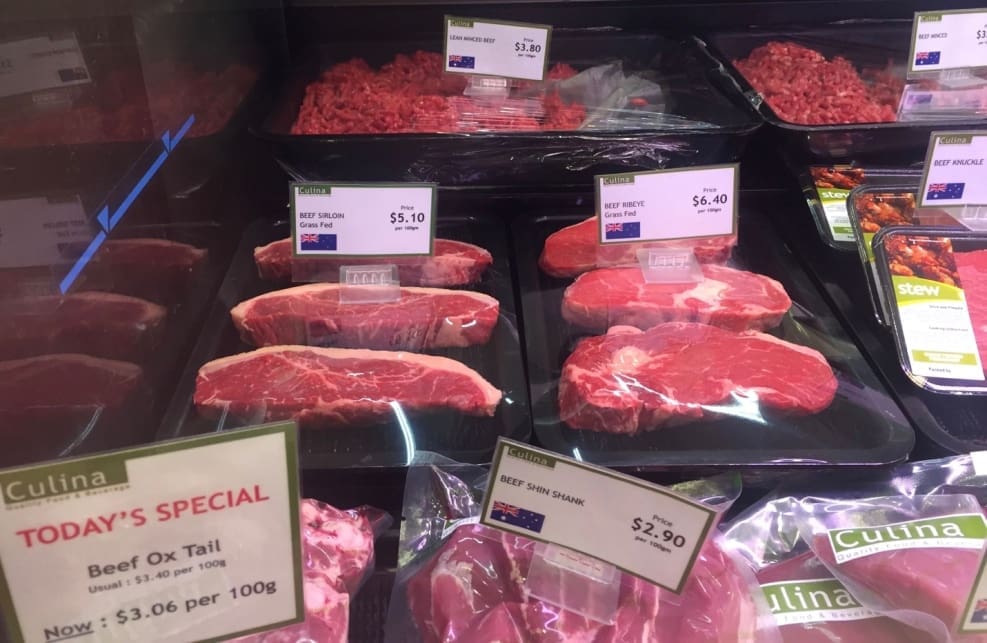
Fair Price Supermarket Scotts Road. Exchange rate about 0.96 Sing$ to AUD$1. Note the prices are per 100grams.
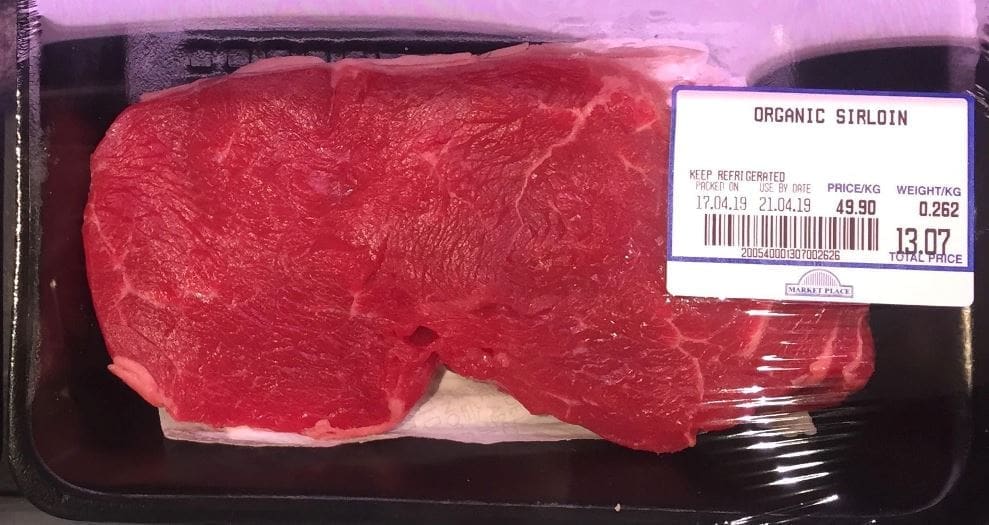
Cold Storage supermarket in the Paragon centre Orchard Road.
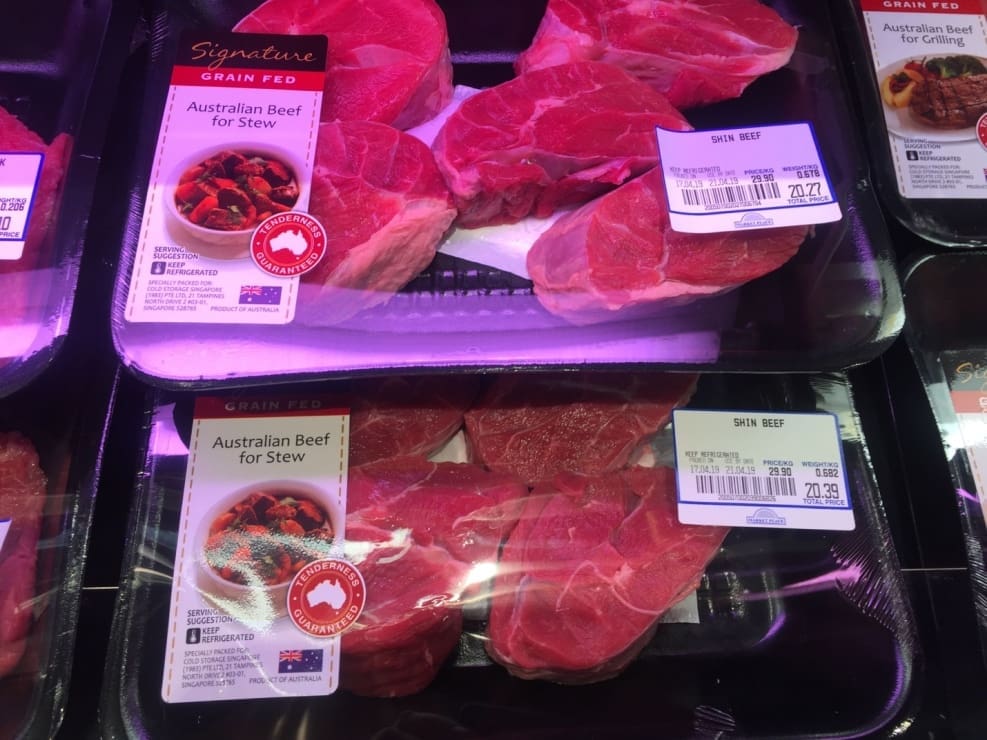
Cold Storage Supermarket Orchard Road.
Now that’s a steak!
I played football with Ian (Foxy) Fox 41 years ago for the Cobram “Tigers” in northern Victoria.
Last week Ian sent me a photo of a steak produced by his Blonde D’Aquitaine cattle bred and fattened on his Cobram property. He markets his beef through Meatsmith in Melbourne and I can’t wait to get down there to try one out, obviously with a few friends to assist.
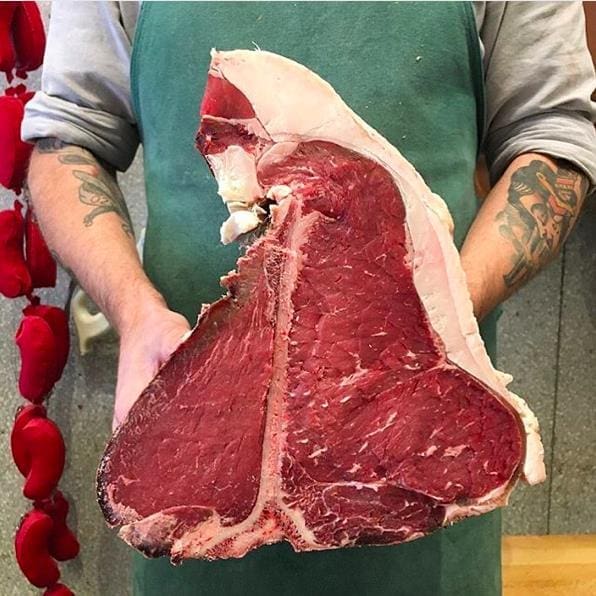
Photo from Ian Fox : a steak from his Blonde cattle shown in the photo below.
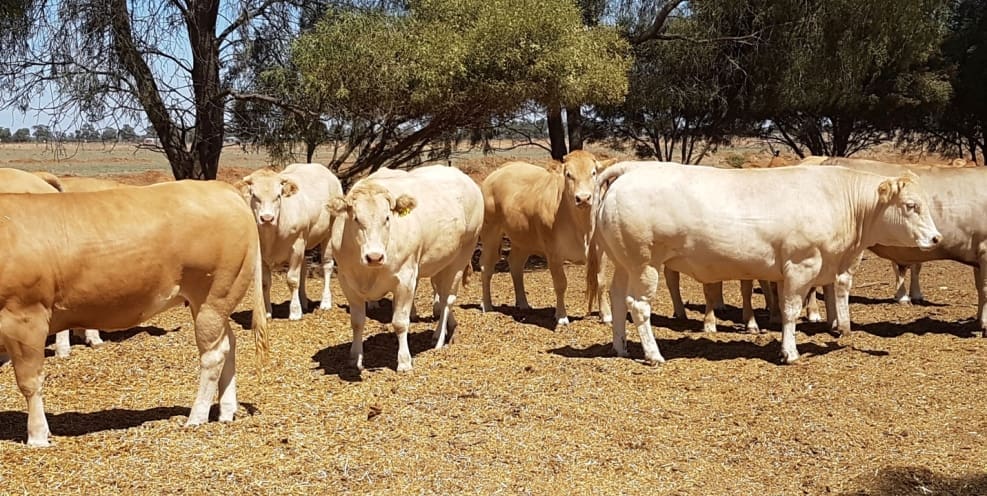
Photo from Ian Fox: some of Ian’s Blonde D’Acquitaine cattle in Cobram, northern Victoria. And these cattle are located in an area experiencing a severe drought.

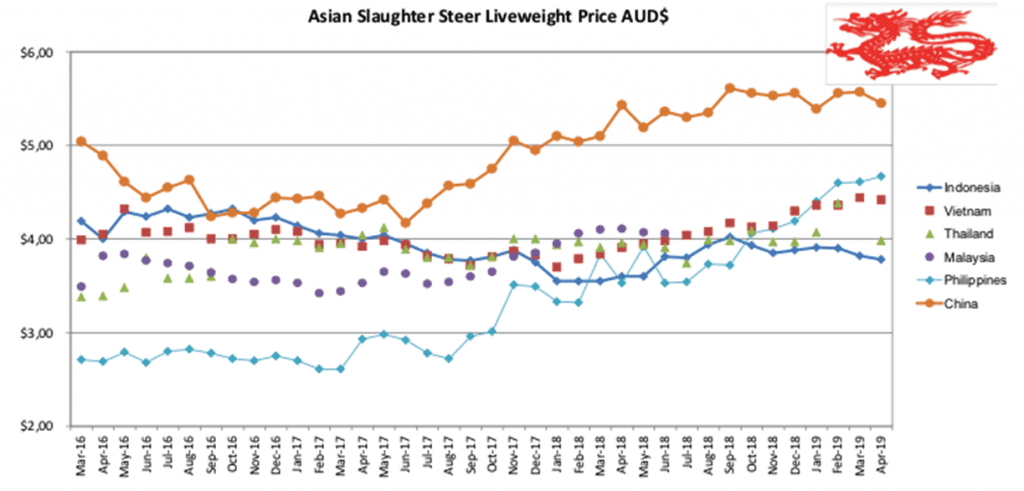


Three guys pulling on the nose ring of a beast is not a great look.
At least Foxy didn’t kick the footy the wrong way during the Grand final that we won despite your indiscretion
Good looking Blondes by the way!